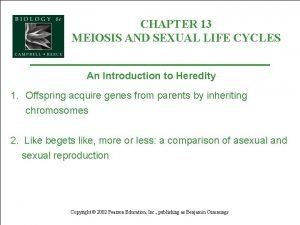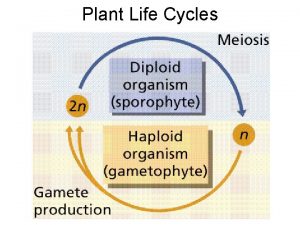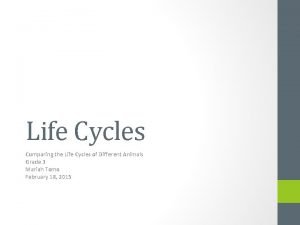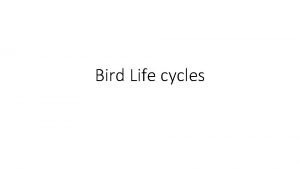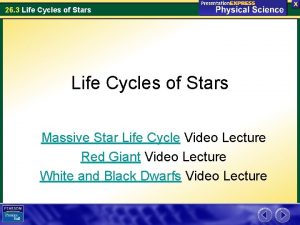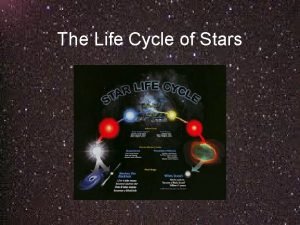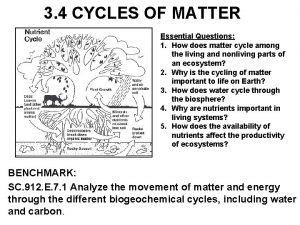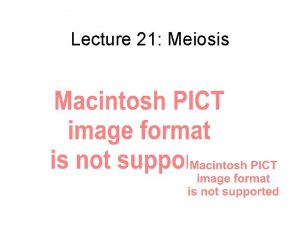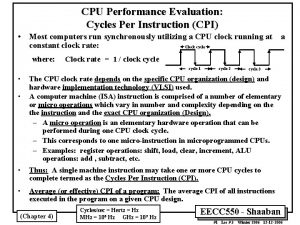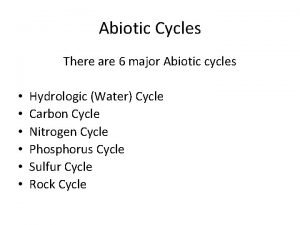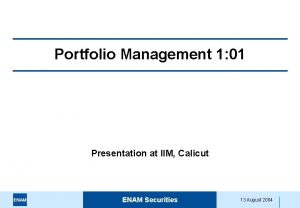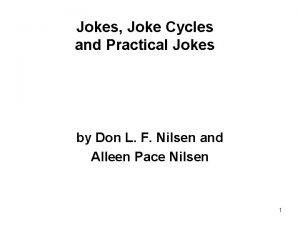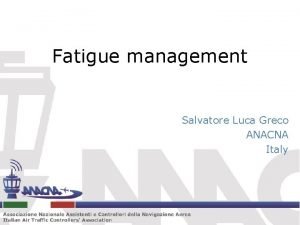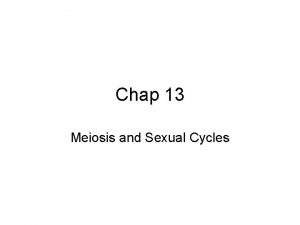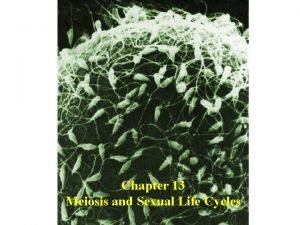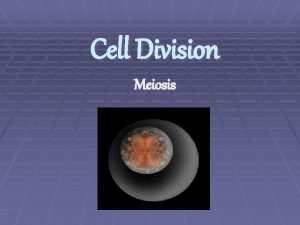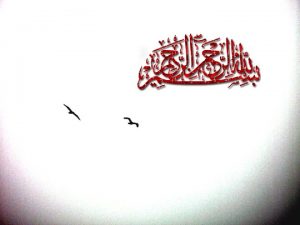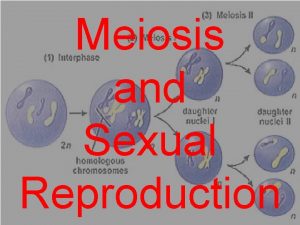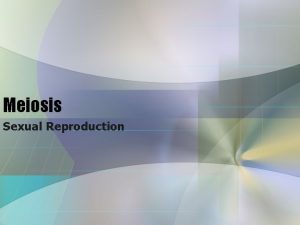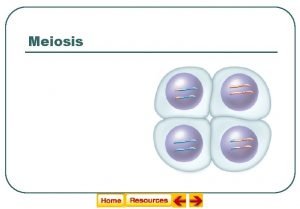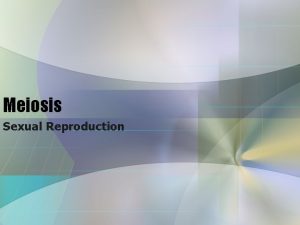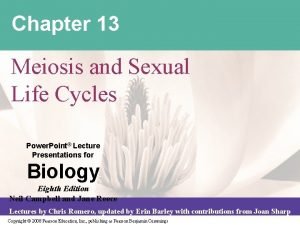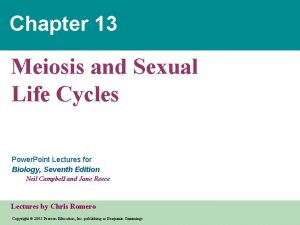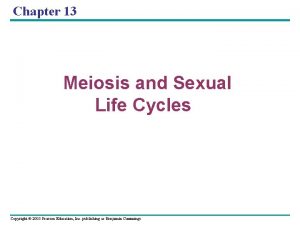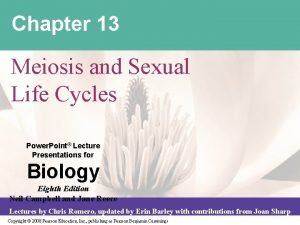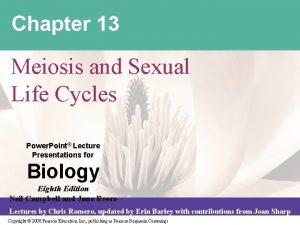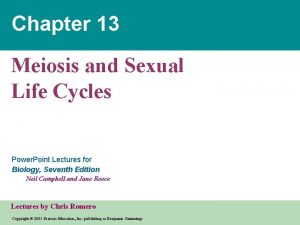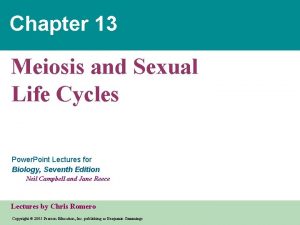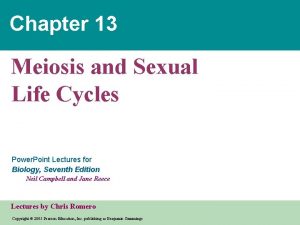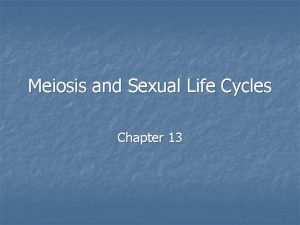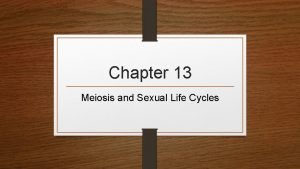Chapter 13 Meiosis and Sexual Life Cycles http












































- Slides: 44

Chapter 13 Meiosis and Sexual Life Cycles http: //www. sumanasinc. com/webcontent/animations/content/ meiosis. html Power. Point® Lecture Presentations for Biology Eighth Edition Neil Campbell and Jane Reece Lectures by Chris Romero, updated by Erin Barley with contributions from Joan Sharp Copyright © 2008 Pearson Education, Inc. , publishing as Pearson Benjamin Cummings

Overview: Variations on a Theme • Living organisms are distinguished by their ability to reproduce their own kind: • Genetics is the scientific study of heredity and variation. • Heredity is the transmission of traits from one generation to the next. • Variation is demonstrated by the differences in appearance that offspring show from parents and siblings. Copyright © 2008 Pearson Education Inc. , publishing as Pearson Benjamin Cummings

Acquiring Genes from Parents • In a literal sense, children do not inherit particular physical traits from their parents…it is genes that are actually inherited. • Genes are the units of heredity, and are made up of segments of DNA • Genes are passed to the next generation through reproductive cells called gametes (sperm and eggs). • Each gene has a specific location called a locus on a certain chromosome. • Most DNA is packaged into chromosomes. • One set of chromosomes is inherited from each parent. Copyright © 2008 Pearson Education Inc. , publishing as Pearson Benjamin Cummings

Fig. 14 -4

Comparison of Asexual and Sexual Reproduction • In asexual reproduction, one parent produces genetically identical offspring by mitosis. • A clone is a group of genetically identical individuals from the same parent. • In sexual reproduction, two parents give rise to offspring that have unique combinations of genes inherited from the two parents. • Advantages: results in greater genetic variation! Copyright © 2008 Pearson Education Inc. , publishing as Pearson Benjamin Cummings

Fig. 13 -2 0. 5 mm Parent Bud (a) Hydra (b) Redwoods

Sexual Life Cycles • Fertilization and meiosis alternate in sexual life cycles • A life cycle is the generation-to-generation sequence of stages in the reproductive history of an organism Copyright © 2008 Pearson Education Inc. , publishing as Pearson Benjamin Cummings

Sets of Chromosomes in Human Cells • Human somatic cells (any cell other than a gamete) have 23 pairs of chromosomes. • A karyotype is an ordered display of the pairs of chromosomes from a cell. • The two chromosomes in each pair are called homologous chromosomes, or homologs. • Chromosomes in a homologous pair are the same length and carry genes controlling the same inherited characters. One is inherited from the mother, and the other from the father. Copyright © 2008 Pearson Education Inc. , publishing as Pearson Benjamin Cummings

Fig. 13 -3 b 5 µm Pair of homologous replicated chromosomes Centromere Sister chromatids Metaphase chromosome

Homologous Chromosomes • HOMOLOGOUS CHROMOSOMES are chromosome pairs of the same length, centromere position, staining pattern, and gene possession for the same characters: – One homologous chromosome is inherited from the organism’s father and the other from the mother. • DIPLOID – means “two sets” – This represents the cells in which the chromosomes are paired up and have a partner in size and shape. – A cell containing TWO sets of chromosomes (2 n), one set inherited from each parent is referred to as a DIPLOID CELL. Copyright © 2008 Pearson Education Inc. , publishing as Pearson Benjamin Cummings

Figure 13. x 2 Human female chromosomes shown by bright field G-banding Where are the homologous chromosomes?

Homologous Chromosomes in Human Female

DIPLOID • Each pair of homologous chromosomes includes one chromosome from each parent • The 46 chromosomes in a human somatic cell are two sets of 23: one from the mother and one from the father • A diploid cell (2 n) has two sets of chromosomes • For humans, the diploid number is 46 (2 n = 46) Copyright © 2008 Pearson Education Inc. , publishing as Pearson Benjamin Cummings

Fig. 13 -4 Key 2 n = 6 Maternal set of chromosomes (n = 3) Paternal set of chromosomes (n = 3) Two sister chromatids of one replicated chromosome Two nonsister chromatids in a homologous pair Centromere Pair of homologous chromosomes (one from each set)

Sex Chromosomes v. Autosomes • The sex chromosomes are called X and Y • Human females have a homologous pair of X chromosomes (XX) • Human males have one X and one Y chromosome (XY) • The 22 pairs of chromosomes that do not determine sex are called autosomes Copyright © 2008 Pearson Education Inc. , publishing as Pearson Benjamin Cummings

Haploid • A gamete (sperm or egg) contains a single set of chromosomes, and is haploid (n) • For humans, the haploid number is 23 (n = 23) • Each set of 23 consists of 22 autosomes and a single sex chromosome • In an unfertilized egg (ovum), the sex chromosome is X • In a sperm cell, the sex chromosome may be either X or Y Copyright © 2008 Pearson Education Inc. , publishing as Pearson Benjamin Cummings

HAPLOID • HAPLOID – means “one set”; this describes the sex cells or gametes (EGG AND SPERM) – these contain only a SINGLE set of chromosomes. – So, for a human, somatic cells are diploid and have a chromosome number of 46 (23 pairs). – But, sex cells are haploid, and have a chromosome number of JUST 23. Copyright © 2008 Pearson Education Inc. , publishing as Pearson Benjamin Cummings

Fig. 13 -5 Key Haploid gametes (n = 23) Haploid (n) Egg (n) Diploid (2 n) Sperm (n) MEIOSIS Ovary FERTILIZATION Testis Diploid zygote (2 n = 46) Mitosis and development Multicellular diploid adults (2 n = 46)

Meiosis is REDUCTION DIVISION • Meiosis reduces the number of chromosome sets from diploid to haploid • Like mitosis, meiosis is preceded by the replication of chromosomes • Meiosis takes place in two sets of cell divisions, called meiosis I and meiosis II • The two cell divisions result in four daughter cells, rather than the two daughter cells in mitosis • Each daughter cell has only half as many chromosomes as the parent cell Copyright © 2008 Pearson Education Inc. , publishing as Pearson Benjamin Cummings

The Stages of Meiosis • In the first cell division (meiosis I), homologous chromosomes separate • Meiosis I results in two haploid daughter cells with replicated chromosomes; it is called the reduction division • In the second cell division (meiosis II), sister chromatids separate • Meiosis II results in four haploid daughter cells with unreplicated chromosomes; it is called the equational division Copyright © 2008 Pearson Education Inc. , publishing as Pearson Benjamin Cummings

Fig. 13 -7 -3 Interphase Homologous pair of chromosomes in diploid parent cell Chromosomes replicate Homologous pair of replicated chromosomes Sister chromatids Diploid cell with replicated chromosomes Meiosis I 1 Homologous chromosomes separate Haploid cells with replicated chromosomes Meiosis II 2 Sister chromatids separate Haploid cells with unreplicated chromosomes

Overview of Stages of Meiosis • MEIOSIS is divided into two distinct stages: 1. Meiosis I 2. Meiosis II • Meiosis I is very similar to mitosis, except that the duplicated chromosomes do not separate the chromatids; instead, the homologous chromosomes line up and form a TETRAD and the homologues separate. • Meiosis II begins WITHOUT a copying of chromosomes; thus, when division occurs, there are less chromosomes in the resulting daughter cells that were in the parent cell – this accomplishes reduction division Copyright © 2008 Pearson Education Inc. , publishing as Pearson Benjamin Cummings

Figure 13. 7 The stages of meiotic cell division: Meiosis I

Figure 13. 7 The stages of meiotic cell division: Meiosis II

Crossing Over During Meiosis I • As homologous chromosomes pair up and form tetrads in meiosis I, they may exchange portions of their chromatids. – This event is called CROSSING OVER. • This results in an exchange of genetic material that gives new gene combinations: – The site at which the exchange occurs is called the chiasma. Copyright © 2008 Pearson Education Inc. , publishing as Pearson Benjamin Cummings

Figure 13. 10 The results of crossing over during meiosis. During prophase I of meiosis, the duplicated chromosomes pair with their homologues, in a process called synapsis. During this process, a protein “zipper” called the synaptonemal complex holds the homologous chromosomes tightly together all along their lengths. When this complex disappears in late prophase, the four closely associated chromatids of a homologous pair are visible as a tetrad. Crossing Over (exchanging portions of homologous chromosomes) occurs during PROPHASE I OF MEIOSIS I. The site at which the crossing over exchange occurs is called the chiasma. Crossing over gives rise to recombinant chromosomes, individual chromosomes that have some combination of DNA originally derived from 2 different parents.

Males: each round of meiosis produces 4 sperm Females: each round of meiosis produces 1 egg and 3 polar bodies

Errors in Meiosis Copyright © 2008 Pearson Education Inc. , publishing as Pearson Benjamin Cummings

Parthenogenesis & Cloning • Both bypass typical meiotic processes! • Parthenogenesis is a type of reproduction, occurring in some insects and flowers, in which the unfertilized ovum develops directly into a new individual • Does not necessarily produce identical clones of the parent. • Rare in plants! • Cloning occurs when an organism is descended asexually from a single ancestor, such as a plant produced by layering or a polyp produced by budding. • Offspring is IDENTICAL to parent! Copyright © 2008 Pearson Education Inc. , publishing as Pearson Benjamin Cummings

A Comparison of Mitosis and Meiosis • Mitosis conserves the number of chromosome sets, producing cells that are genetically identical to the parent cell • Meiosis reduces the number of chromosomes sets from two (diploid) to one (haploid), producing cells that differ genetically from each other and from the parent cell • The mechanism for separating sister chromatids is virtually identical in meiosis II and mitosis Copyright © 2008 Pearson Education Inc. , publishing as Pearson Benjamin Cummings

Figure 13. 8 A comparison of mitosis and meiosis

Figure 13. 8 A comparison of mitosis and meiosis: summary IPMAT + cytokinesis

Events Unique to Meiosis • Three events are unique to meiosis, and all three occur in meiosis l: – Synapsis and crossing over in prophase I: Homologous chromosomes physically connect and exchange genetic information – At the metaphase plate, there are paired homologous chromosomes (tetrads), instead of individual replicated chromosomes – At anaphase I, it is homologous chromosomes, instead of sister chromatids, that separate Copyright © 2008 Pearson Education Inc. , publishing as Pearson Benjamin Cummings

Genetic Variation and Evolution • Genetic variation produced in sexual life cycles contributes to evolution. • Mutations (changes in an organism’s DNA) are the original source of genetic diversity • Mutations create different versions of genes called alleles • Reshuffling of alleles during sexual reproduction produces genetic variation Copyright © 2008 Pearson Education Inc. , publishing as Pearson Benjamin Cummings

Origins of Genetic Variation Among Offspring • The behavior of chromosomes during meiosis and fertilization is responsible for most of the variation that arises in each generation • Three mechanisms contribute to genetic variation: – Independent assortment of chromosomes – Crossing over – Random fertilization Copyright © 2008 Pearson Education Inc. , publishing as Pearson Benjamin Cummings

Independent Assortment of Chromosomes • Homologous pairs of chromosomes orient randomly at metaphase I of meiosis • In independent assortment, each pair of chromosomes sorts maternal and paternal homologues into daughter cells independently of the other pairs • The number of combinations possible when chromosomes assort independently into gametes is 2 n, where n is the haploid number • For humans (n = 23), there are more than 8 million (223) possible combinations of chromosomes Copyright © 2008 Pearson Education Inc. , publishing as Pearson Benjamin Cummings

Fig. 13 -11 -3 Possibility 2 Possibility 1 Two equally probable arrangements of chromosomes at metaphase I Metaphase II Daughter cells Combination 1 Combination 2 Combination 3 Combination 4

Crossing Over • Crossing over produces recombinant chromosomes, which combine genes inherited from each parent • Crossing over begins very early in prophase I, as homologous chromosomes pair up gene by gene • In crossing over, homologous portions of two nonsister chromatids trade places (and their respective alleles) • Crossing over contributes to genetic variation by combining DNA from two parents into a single chromosome Copyright © 2008 Pearson Education Inc. , publishing as Pearson Benjamin Cummings

Fig. 13 -12 -5 Prophase I of meiosis Pair of homologs Nonsister chromatids held together during synapsis Chiasma Centromere TEM Anaphase II Daughter cells Recombinant chromosomes

Random Fertilization • Random fertilization adds to genetic variation because any sperm can fuse with any ovum (unfertilized egg) • The fusion of two gametes (each with 8. 4 million possible chromosome combinations from independent assortment) produces a zygote with any of about 70 trillion diploid combinations • Crossing over adds even more variation • Each zygote has a unique genetic identity Copyright © 2008 Pearson Education Inc. , publishing as Pearson Benjamin Cummings

Review of Key Concepts • Meiosis, a reduction division, followed by fertilization ensures genetic diversity in sexually reproducing organisms. • Meiosis ensures that each gamete receives one complete haploid (1 n) set of chromosomes. • During meiosis, homologous chromosomes are paired, with one homologue originating from the maternal parent and the other from the paternal parent. • Orientation of the chromosome pairs is random with respect to the cell poles. Copyright © 2008 Pearson Education Inc. , publishing as Pearson Benjamin Cummings

Review of Key Concepts • Separation of the homologous chromosomes ensures that each gamete receives a haploid (1 n) set of chromosomes composed of both maternal and paternal chromosomes. • During meiosis, homologous chromatids exchange genetic material via a process called “crossing over, ” which increases genetic variation in the resultant gametes. • Fertilization involves the fusion of two gametes, increases genetic variation in populations by providing for new combinations of genes in the zygote, and restores the diploid number of chromosomes. Copyright © 2008 Pearson Education Inc. , publishing as Pearson Benjamin Cummings

Fig. 13 -UN 4

You should now be able to: 1. Distinguish between the following terms: somatic cell and gamete; autosome and sex chromosomes; haploid and diploid 2. Describe the events that characterize each phase of meiosis 3. Describe three events that occur during meiosis I but not mitosis 4. Name and explain the three events that contribute to genetic variation in sexually reproducing organisms Copyright © 2008 Pearson Education Inc. , publishing as Pearson Benjamin Cummings
 Chapter 13 meiosis and sexual life cycles
Chapter 13 meiosis and sexual life cycles Chapter 13 meiosis and sexual life cycles
Chapter 13 meiosis and sexual life cycles Crossing over occurs during
Crossing over occurs during Chapter 10 section 1: meiosis
Chapter 10 section 1: meiosis Meiosis introduction activity
Meiosis introduction activity Sexual reproduction and genetics section 1 meiosis
Sexual reproduction and genetics section 1 meiosis Sexual reproduction and genetics section 1 meiosis
Sexual reproduction and genetics section 1 meiosis Differences between mitosis and meiosis
Differences between mitosis and meiosis Fadlife
Fadlife Plant life cycles and alternation of generations
Plant life cycles and alternation of generations Anaphase in meiosis vs mitosis
Anaphase in meiosis vs mitosis Tetrad meiosis
Tetrad meiosis Oogensis
Oogensis Cycle.of life
Cycle.of life Rvguev suicide
Rvguev suicide Life cycle of a bird
Life cycle of a bird Section 26.3 life cycles of stars
Section 26.3 life cycles of stars What is charted on an hr diagram?
What is charted on an hr diagram? Fungal life cycles
Fungal life cycles Matter cycle
Matter cycle Http://www.cellsalive.com/
Http://www.cellsalive.com/ How is meiosis different in males and females
How is meiosis different in males and females Compare and contrast carbon and nitrogen cycles
Compare and contrast carbon and nitrogen cycles Pedigree miscarriage symbol
Pedigree miscarriage symbol Chapter 10 sexual reproduction and genetics
Chapter 10 sexual reproduction and genetics Ehlers trading
Ehlers trading Http //mbs.meb.gov.tr/ http //www.alantercihleri.com
Http //mbs.meb.gov.tr/ http //www.alantercihleri.com Http //pelatihan tik.ung.ac.id
Http //pelatihan tik.ung.ac.id Meiosis
Meiosis Chapter 20 sexual reproduction in animals packet answers
Chapter 20 sexual reproduction in animals packet answers Mandarin cycles
Mandarin cycles Biogeochemical cycles of water
Biogeochemical cycles of water Pdsa cycle nursing
Pdsa cycle nursing Precession milankovitch cycles
Precession milankovitch cycles Transaction cycle flow chart
Transaction cycle flow chart Cpi cycles per instruction
Cpi cycles per instruction Biogeochemical cycles performance task
Biogeochemical cycles performance task Apes nutrient cycles
Apes nutrient cycles What is the major abiotic reservoir for phosphorus
What is the major abiotic reservoir for phosphorus What happens to phosphorus that erodes from rock and soil?
What happens to phosphorus that erodes from rock and soil? Cycles in nature
Cycles in nature Joke cycles
Joke cycles Joke cycles
Joke cycles Biogeochemical cycles class 9 ppt
Biogeochemical cycles class 9 ppt Sleep wake cycle
Sleep wake cycle

